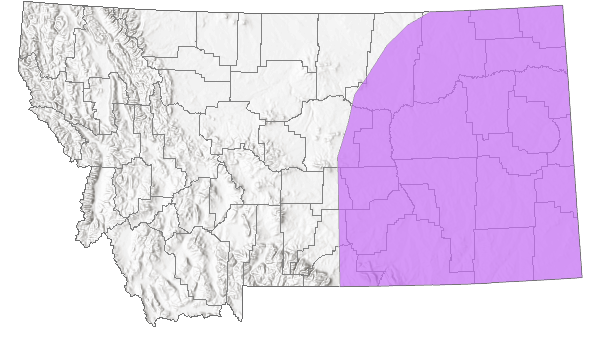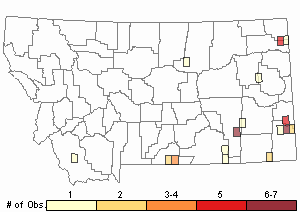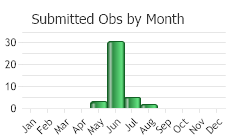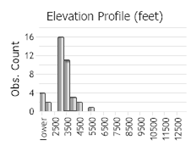View in other NatureServe Network Field Guides
NatureServe
Montana
Utah
Wyoming
Idaho
Wisconsin
British Columbia
South Carolina
Yukon
California
New York
Plains Phlox - Phlox andicola
State Rank Reason (see State Rank above)
Plains phlox reaches the western margin of its range in Montana's eastern counties. It has been documented from relatively few locations, but surveys during its early blooming season have been few, and additional spring inventory work may locate more populations. It likely tolerates grazing and may benefit from some level of disturbance.
- Details on Status Ranking and Review
Population Size
Score1 - Moderate: Generally 10,000-100,000 individuals.
Range Extent
Score0-1 - Widespread to Sporadically Distributed: Species has a distribution in the state such that it is borderline in its classification or its distribution is too imprecisely documented to place it in one class.
Area of Occupancy
Score1-2 - Low to Moderate. Occurs in 4-25 Subwatersheds (6th Code HUC’s), though the species' distribution is not sufficiently documented to place it within one class.
Environmental Specificity
Score1 - Moderate: Species is restricted to a specific habitat that is more widely distributed or to several restricted habitats and is typically dependent upon relatively unaltered, good-quality habitat (C Values of 5-7).
CommentGenerally limited to sandy soils.
Trends
ScoreNA - Rank factor not assessed.
Threats
Score0-1 - Low to Medium.
CommentNo specific threats have been identified.
Intrinsic Vulnerability
Score0 - Low Vulnerability: Species does not have any unusual or specific life history or biological attributes or limted reproductive potential which makes it susceptible to extirpation from stochastic events or other adverse impacts to its habitat and thus slow to recover.
Raw Conservation Status Score
Score
3 to 6 total points scored out of a possible 16 (Rarity factors and threats only).
General Description
Plains Phlox is a perennial herb with loosely tufted stems that are 4-10 cm high arising from creeping rhizomes. The 5-8 pairs of opposite, linear leaves have prominent midveins and whitish bases and are 10-25 mm long, ca. 1 mm wide and come to a sharp point. Foliage is glabrous to sparsely hairy. Stems are white. 1-5 white flowers are borne at the stem tips. Each flower has 5 petals and a tubular corolla. The calyx is also tubular, with 5 lobes, tangled long hairs, and 6-11 mm length.
Phenology
Flowering occurs in May and early June.
Diagnostic Characteristics
Phlox hoodii and P. bryoides have shorter leaves, only 1 flower per stem, and shorter corolla lobes (3-5 mm). Leaves of P. alyssifolia are 2-5 mm wide, and the calyx tube is equal to the lobes. Dimensions of the largest P. hoodii plants may overlap with those of the smallest P. andicola. Flowers are needed for positive identification, and hybridization has been reported among these species (Great Plains Flora Association 1986).
Species Range
Montana Range
Range Descriptions

 Native
Native
Range Comments
Great Plains, from ND to MT, south from KS to CO. Peripheral.
Observations in Montana Natural Heritage Program Database
Number of Observations: 44
(Click on the following maps and charts to see full sized version)
Map Help and Descriptions
Relative Density

Recency



 (Observations spanning multiple months or years are excluded from time charts)
(Observations spanning multiple months or years are excluded from time charts)
Habitat
Plains phlox occupies a wide range of habitats in the center of its range, including sparsely vegetated outcrops, sandplains, and heavy alkaline clays (Barr 1983). In Montana, it is known mainly from sandy soils in grasslands and ponderosa pine woodland, often associated with sparsely vegetated erosional blowouts and loose sand below sandstone outcrops. Dominants in this habitat include Stipa comata, Bouteloua gracilis, Agropyron smithii, Carex heliophila, and C. filifolia. Associated species in Sheridan and Carter counties include Psoralea argophylla, P. lanceolata, Calamovilfa longifolia, Andropogon scoparius, Artemisia ludoviciana, A. frigida, Rhus trilobata, Poa sandbergii and Opuntia polyacantha.
Given the large size of some Montana populations of plains phlox, its distribution across at least four counties, and its close resemblance to Phlox hoodii, it seems likely that Phlox andicola is more widespread than current records suggest. It is characterized as "frequent on dry prairies and plains in western South Dakota" (Van Bruggen 1985), and early-season surveys will likely provide additional Montana records for this species.
Ecological Systems Associated with this Species
Ecology
Plains phlox is long-lived, with very deep, woody roots (Barr 1983). Prairie phlox species can reproduce by rhizomes as well as by seeds, and are generally adapted to insect-pollination. This species occupies sparsely vegetated, mid-successional habitats, and is one of several sand-loving Species of Concern often found where the habitat is extensive and/or in good condition.
POLLINATORS The following animal species have been reported as pollinators of this plant species or its genus where their geographic ranges overlap:
Bombus vagans,
Bombus flavifrons,
Bombus melanopygus,
Bombus pensylvanicus,
Bombus bimaculatus,
Bombus griseocollis,
Bombus impatiens, and
Bombus kirbiellus (Shaw and Taylor 1986, Colla and Dumesh 2010).
Management
Montana populations are in sparsely vegetated habitats that receive little use by livestock, and the low growing form of Phlox andicola makes it resistant to browsing. The species appears to be adapted to small-scale disturbance, and its habitat may be fostered by management that involves some disturbance. One of the larger populations documented was in a calving pasture. Another survey reported it to be particularly vigorous in burned areas.
Stewardship Responsibility
References
- Literature Cited AboveLegend:
 View Online Publication
View Online Publication Colla, S.R. and S. Dumesh. 2010. The bumble bees of southern Ontario: notes on natural history and distribution. Journal of the Entomological Society of Ontario 141:39-68.
Colla, S.R. and S. Dumesh. 2010. The bumble bees of southern Ontario: notes on natural history and distribution. Journal of the Entomological Society of Ontario 141:39-68. Shaw, D.C. and R.J. Taylor.1986. Pollination ecology of an alpine fell-field community in the North Cascades. Northwest Science 60:21-31.
Shaw, D.C. and R.J. Taylor.1986. Pollination ecology of an alpine fell-field community in the North Cascades. Northwest Science 60:21-31.
- Additional ReferencesLegend:
 View Online Publication
View Online Publication
Do you know of a citation we're missing? Barr, C.A. 1983. Jewels of the Plains. University of Minnesota Press, Minneapolis, Minnesota. 236 pp.
Barr, C.A. 1983. Jewels of the Plains. University of Minnesota Press, Minneapolis, Minnesota. 236 pp. Heidel, B.L. 1994. Sensitive plant species survey in Garfield and McCone Counties, Montana. Unpublished report to the Bureau of Land Management. Montana Natural Heritage Program, Helena, Montana. 58 pp. plus appendices.
Heidel, B.L. 1994. Sensitive plant species survey in Garfield and McCone Counties, Montana. Unpublished report to the Bureau of Land Management. Montana Natural Heritage Program, Helena, Montana. 58 pp. plus appendices. Heidel, B.L. and K.H. Dueholm. 1995. Sensitive plant survey in the Sioux District, Custer National Forest, 1994, Carter County, Montana and Harding County, South Dakota. Unpublished report to the Custer National Forest. Montana Natural Heritage Program, Helena, Montana. 95 pp. plus appendices.
Heidel, B.L. and K.H. Dueholm. 1995. Sensitive plant survey in the Sioux District, Custer National Forest, 1994, Carter County, Montana and Harding County, South Dakota. Unpublished report to the Custer National Forest. Montana Natural Heritage Program, Helena, Montana. 95 pp. plus appendices. Heidel, B.L., S.V. Cooper and C. Jean. 2000. Plant species of special concern and plant associations of Sheridan County, Montana. Report to U.S. Fish and Wildlife Service. Montana Natural Heritage Program, Helena, Montana. 96 p.
Heidel, B.L., S.V. Cooper and C. Jean. 2000. Plant species of special concern and plant associations of Sheridan County, Montana. Report to U.S. Fish and Wildlife Service. Montana Natural Heritage Program, Helena, Montana. 96 p. Lesica, P., M.T. Lavin, and P.F. Stickney. 2012. Manual of Montana Vascular Plants. Fort Worth, TX: BRIT Press. viii + 771 p.
Lesica, P., M.T. Lavin, and P.F. Stickney. 2012. Manual of Montana Vascular Plants. Fort Worth, TX: BRIT Press. viii + 771 p. Lesica, P., M.T. Lavin, and P.F. Stickney. 2022. Manual of Montana Vascular Plants, Second Edition. Fort Worth, TX: BRIT Press. viii + 779 p.
Lesica, P., M.T. Lavin, and P.F. Stickney. 2022. Manual of Montana Vascular Plants, Second Edition. Fort Worth, TX: BRIT Press. viii + 779 p. McGregor, R.L. (coordinator), T.M. Barkley, R.E. Brooks, and E.K. Schofield (eds). 1986. Flora of the Great Plains: Great Plains Flora Association. Lawrence, KS: Univ. Press Kansas. 1392 pp.
McGregor, R.L. (coordinator), T.M. Barkley, R.E. Brooks, and E.K. Schofield (eds). 1986. Flora of the Great Plains: Great Plains Flora Association. Lawrence, KS: Univ. Press Kansas. 1392 pp. Van Bruggen, T. 1985. The vascular plants of South Dakota, 2nd ed. Iowa State University Press, Ames, Iowa. 476 pp.
Van Bruggen, T. 1985. The vascular plants of South Dakota, 2nd ed. Iowa State University Press, Ames, Iowa. 476 pp. Vanderhorst, J.P., S.V. Cooper, and B.L. Heidel. 1998. Botanical and vegetation survey of Carter County, Montana. Unpublished report prepared for the Bureau of Land Management. Montana Natural Heritage Program, Helena. 116 pp. + app.
Vanderhorst, J.P., S.V. Cooper, and B.L. Heidel. 1998. Botanical and vegetation survey of Carter County, Montana. Unpublished report prepared for the Bureau of Land Management. Montana Natural Heritage Program, Helena. 116 pp. + app.
- Web Search Engines for Articles on "Plains Phlox"





